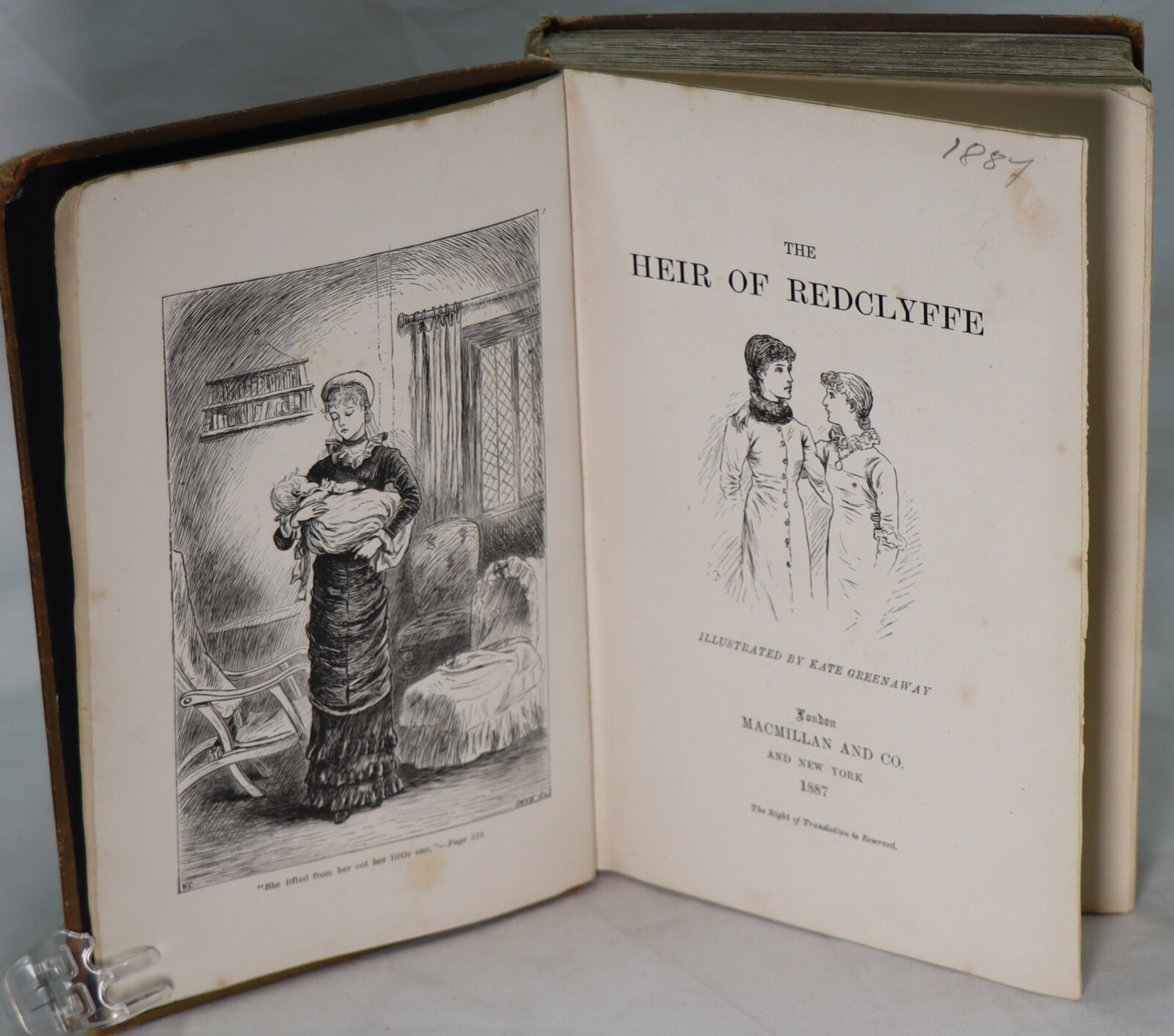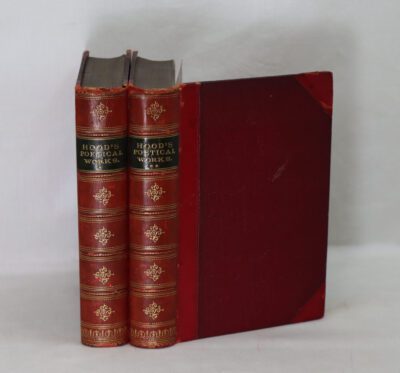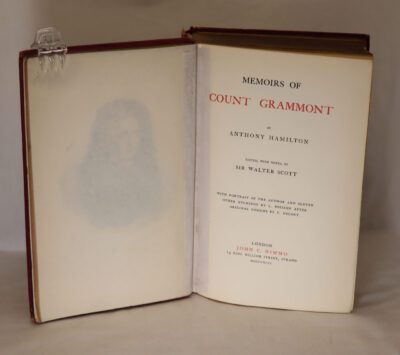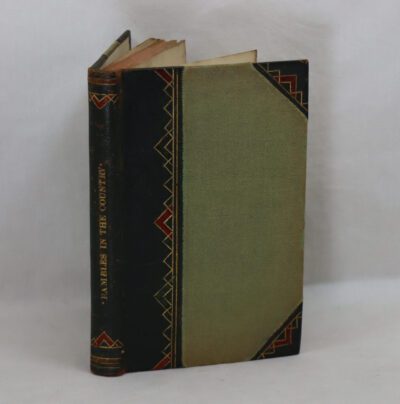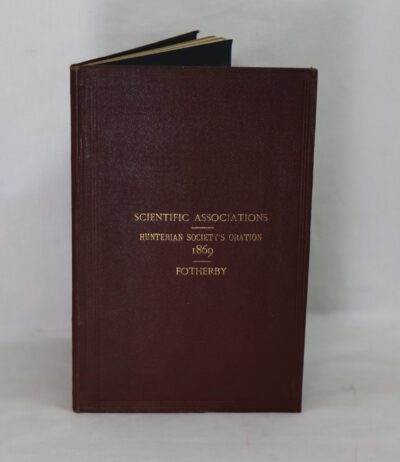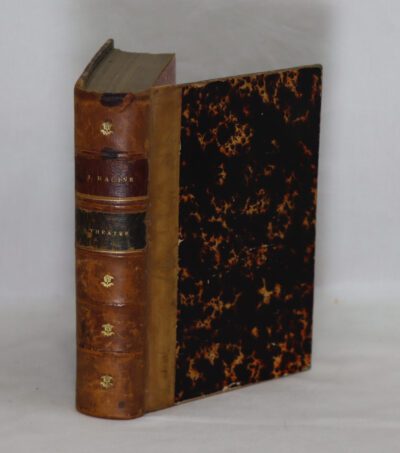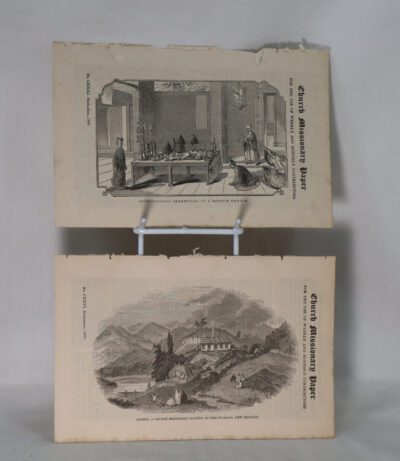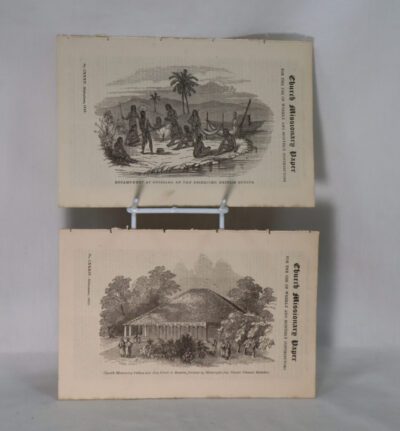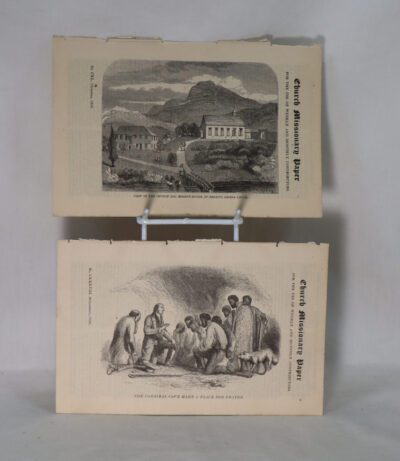The Heir to Redcliffe.
By Charlotte M Yonge
Printed: 1887
Publisher: Macmillan & Co. London
| Dimensions | 14 × 20 × 4 cm |
|---|---|
| Language |
Language: English
Size (cminches): 14 x 20 x 4
Condition: Very good (See explanation of ratings)
Item information
Description
Tan cloth binding with gilt title on the spine.
-
F.B.A. provides an in-depth photographic presentation of this item to stimulate your feeling and touch. More traditional book descriptions are immediately available.
-
Note: This book carries the £5.00 discount to those that subscribe to the F.B.A. mailing list.
A very well kept edition.
The Heir of Redclyffe, published in 1853, was the first of Charlotte M. Yonge’s bestselling romantic novels. Its religious tone is derived from the High Church background of her family and from her friendship with a leading figure in the Oxford Movement, John Keble, who closely supervised the writing of the book. The germ of its plot was suggested by her friend Marianne Dyson. According to J. B. Priestley The Heir of Redclyffe was “the most popular novel of the whole age…Its popularity left Dickens and Thackeray far behind.”
Synopsis
The Heir of Redclyffe tells the story of Guy Morville, heir to the Redclyffe estate and baronetcy, and his cousin Philip Morville, a conceited hypocrite who enjoys an unwarrantedly high reputation, and of the two sisters whom they love, Amabel and Laura. When Guy raises money to secretly pay off the debts of his blackguard uncle, Philip spreads the rumour that Guy is a reckless gambler. As a result Guy’s proposed marriage to Amabel (Amy), who is his guardian’s daughter, is called off and he is disowned by his guardian. Guy bears the situation with a new-found Christian fortitude until the uncle clears his character, enabling him to marry Amy after all. They honeymoon in Italy, finding Philip there suffering from a life-threatening fever. Guy nurses him back to health, but catches the fever himself and dies. Philip, transformed by contrition, inherits Redclyffe and marries Laura. Amy has a daughter after her husband’s death and says she is happy in her Christian faith and with her daughter.
Readership and critical reception: From the first The Heir of Redclyffe was a tremendous financial success, enabling Yonge to give the Bishop of New Zealand a sum of money to be spent on building a missionary ship, the Southern Cross. The novel’s readers came from a wide social and intellectual range. Many were girls, as is indicated by the fact that one of Louisa May Alcott’s Little Women is found crying over a copy. The author’s brother Julian reported that nearly all the young men in his regiment had a copy. The teenaged George Saintsbury included Guy Morville in a list of “Things and Persons to be Adored”. William Morris and Edward Burne-Jones, when students at Oxford, read the book aloud and decided to adopt the chivalric ideals of Guy Morville as part of the principles of the Pre-Raphaelite Brotherhood. Count Tolstoy must have read The Heir of Redclyffe if the critic John Sutherland is correct in detecting its influence on Anna Karenina. Henry James wrote disparagingly of the “semi-developed novels” read by women and their children, although “Occasionally, like the Heir of Redclyffe, they almost legitimate themselves by the force of genius. But this only when a first-rate mind takes the matter in hand.” Other writers were less indulgent. Wilkie Collins reviewed it scathingly, declaring that “The characters by whose aid the story is worked out, are simply impossible. They have no types in nature, they never did have types in nature, and they never will have types in nature.” Oscar Wilde, while touring America in 1882, spoke with a condemned criminal in a Nebraska jail who said he was reading Charlotte Yonge. Wilde commented later, “My heart was turned by the eyes of the doomed man, but if he reads The Heir of Redclyffe it’s perhaps as well to let the law take its course.”
.Publication history. The Heir of Redclyffe was first published, in two volumes, by the firm of John W. Parker in 1853. Two years later, the Leipzig publisher Bernhard Tauchnitz made it available in Germany. By 1878 it had reached a 23rd edition, and in the following year an edition illustrated by Kate Greenaway appeared. It was published by Everyman’s Library in 1909 with an introduction by Alice Meynell, and by Oxford World’s Classics in 1997 with introduction and notes by Barbara Dennis. A sequel called Amabel and Mary Verena by Mrs. Hicks Beach was published in 1944 by Faber and Faber; it has not been reprinted.
Charlotte Mary Yonge (11 August 1823 – 24 March 1901) was an English novelist, who wrote in the service of the church. Her abundant books helped to spread the influence of the Oxford Movement and show her keen interest in matters of public health and sanitation.
Literary career: Yonge began writing in 1848 and published in her long life about 160 works, chiefly novels. Her first commercial success, The Heir of Redclyffe (1853), provided the funding to put the schooner Southern Cross into service on behalf of George Selwyn. Similar charitable works were done with the profits from later novels. Yonge was also a founder and editor for 40 years of The Monthly Packet, a magazine founded in 1851, with a varied readership, but targeted at British Anglican girls, though in later years it turned to a somewhat wider readership).
Charlotte Mary Yonge later in life
Among her other well-known works are Heartsease, and The Daisy Chain. A Book of Golden Deeds is a collection of true stories of courage and self-sacrifice. Other titles were Cameos from English History, Life of John Coleridge Patteson: Missionary Bishop of the Melanesian Islands, and Hannah More. Her History of Christian Names was described as “the first serious attempt at tackling the subject” and as the standard work on names in the preface to the first edition of Betty Withycombe’s The Oxford Dictionary of English Christian Names (1944).
Around 1859 Yonge created a literary group of younger girl cousins, to write essays and gain advice from Yonge on their writing. Together they created a private magazine, The Barnacle, which continued until about 1871. This was valuable as they may have belonged to the last generation of girls educated at home. Her goddaughter, Alice Mary Coleridge, contributed as “Gurgoyle” to the first issue, drawing the covers and contributing translations, articles and verses.
Yonge’s personal example and influence on her goddaughter Alice Mary Coleridge were formative in her zeal for women’s education, leading indirectly to the foundation of Abbots Bromley School for Girls.
After Yonge’s death, her friend, assistant and collaborator, Christabel Coleridge, published the biographical Charlotte Mary Yonge: her Life and Letters (1903).
Reputation: Yonge’s work was widely read and respected in the 19th century. Among her admirers were Lewis Carroll, George Eliot, William Ewart Gladstone, Charles Kingsley, Christina Rossetti, Alfred, Lord Tennyson, and Anthony Trollope. William Morris and Edward Burne-Jones read The Heir of Redclyffe aloud to each other while undergraduates at Oxford University and “took [the hero, Guy Morville’s] medieval tastes and chivalric ideals as presiding elements in the formation of the Pre-Raphaelite Brotherhood.” Yonge’s work was compared favourably with that of Trollope, Jane Austen, Honoré de Balzac, Gustave Flaubert, and Émile Zola.
Sir John Arthur Ransome Marriott called her: … not only a prolific novelist, but a serious student of history, especially in its personal aspects. Having dealt in The Constable’s Tower with Hubert de Burgh, with his famous defence of Dover Castle against Prince Louis of France (1213), and his still more famous victory at sea off Sandwich, and with Edward I as a crusader (The Prince and the Page), Miss Yonge drew on the Vie de Bertrand du Guesclin as well as on Froissart for her fascinating tale The Lances of Lynwood. With characteristic modesty she expressed the hope that her sketch might “serve as an inducement to some young readers to make acquaintance with the delectable old Canon (Froissart) for themselves.” The wise, of all ages, will fulfil her hope.
So popular were her works that
A midshipman was able to supply from memory a missing page in his ship’s copy of The Daisy Chain. An officer in the Guards, asked in a game of “Confessions” what his prime object in life was, answered that it was to make himself like Guy Morville, hero of The Heir of Redclyffe.
C. S. Lewis thought highly of her, at one point bracketing her evocations of domestic life with those of Homer and Leo Tolstoy. Abraham Kuyper, who read The Heir of Redclyffe on the recommendation of his fiancé, Johanna Schaay, found it a moving experience. The novel was “next to the Bible in its meaning for my life.”m Yonge was one of the favourite writers of Barbara Pym, who mentions Yonge’s novels favourably in several of her own novels.
However, according to the critic Catherine Sandbach-Dahlström, Yonge’s work has been “constantly be-devilled” by a “tendency to confuse the moral quality of [her] view of life with the quality of her literary expression”.
Her novels such as The Daisy Chain, The Young Stepmother, The Trial, and The Three Brides encompass Victorian problems of urban pollution, sanitary reform, and epidemics of cholera and typhoid. She urged social, economic and medical reform of dirt-ridden Victorian cities. The dualism found in her writings, writes Alethea Hayter, “serves to illustrate the triumphs and mistakes of reforming zeal, to contrast selfish irresponsibility with courageous philanthropy, to balance tradition against progress.”
Yonge’s work has been sparely studied, with the possible exception of The Heir of Redclyffe.
Graham Greene used epigraphs from The Little Duke for each chapter of his 1943 novel The Ministry of Fear. In Chapter 1, the protagonist Arthur Rowe buys a copy of the book at a fête for sixpence.
Sculpture of Yonge by Vivien Mallock outside Eastleigh railway station
In 2015 a sculpture by Vivien Mallock was installed outside Eastleigh railway station, as a tribute to Yonge for having effectively named the town. It shows her at the age of about 45, when she named Eastleigh parish. It shows her sitting on a bench with a book on her lap, with space for members of the public to sit alongside her.
Condition notes
Want to know more about this item?
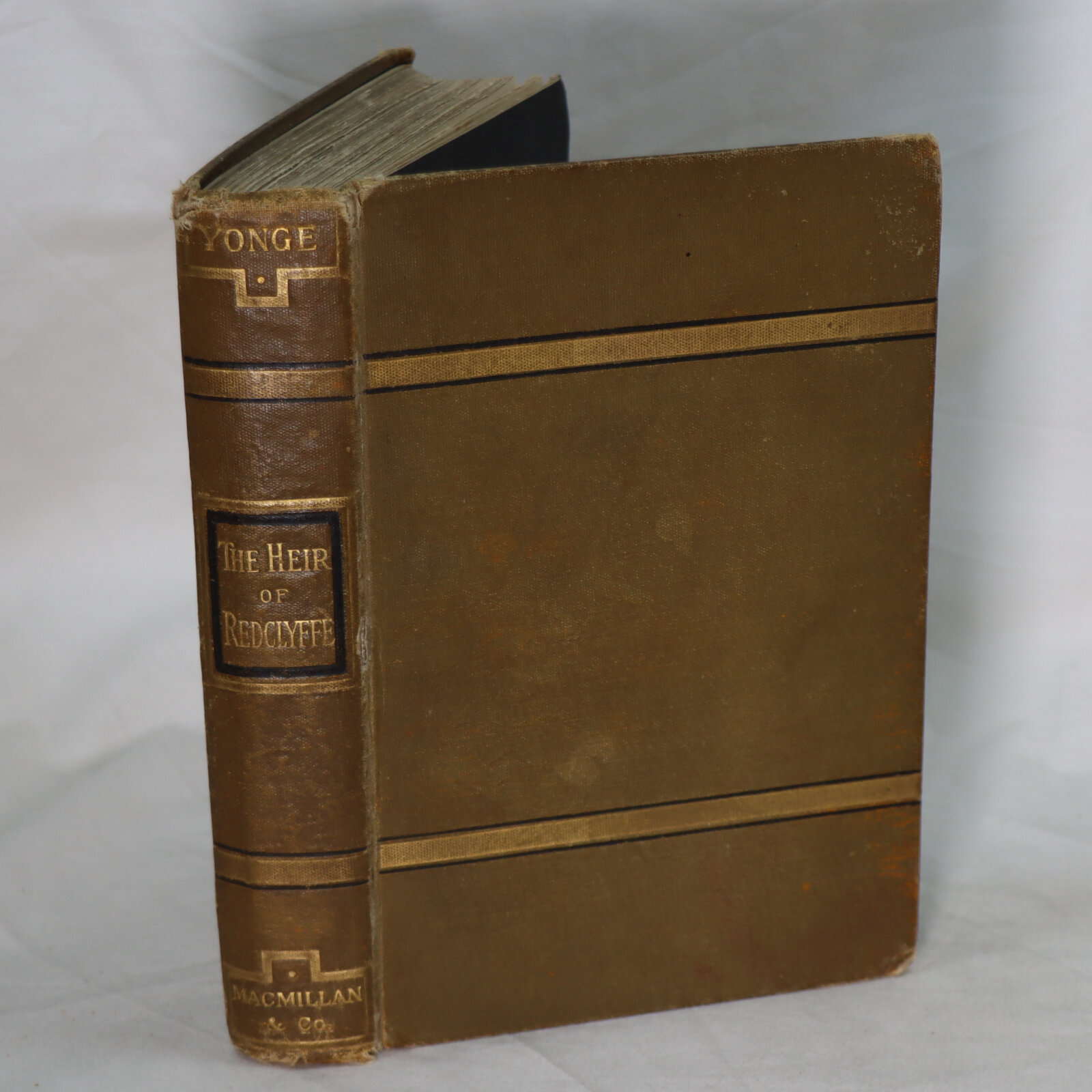
Related products
Share this Page with a friend

